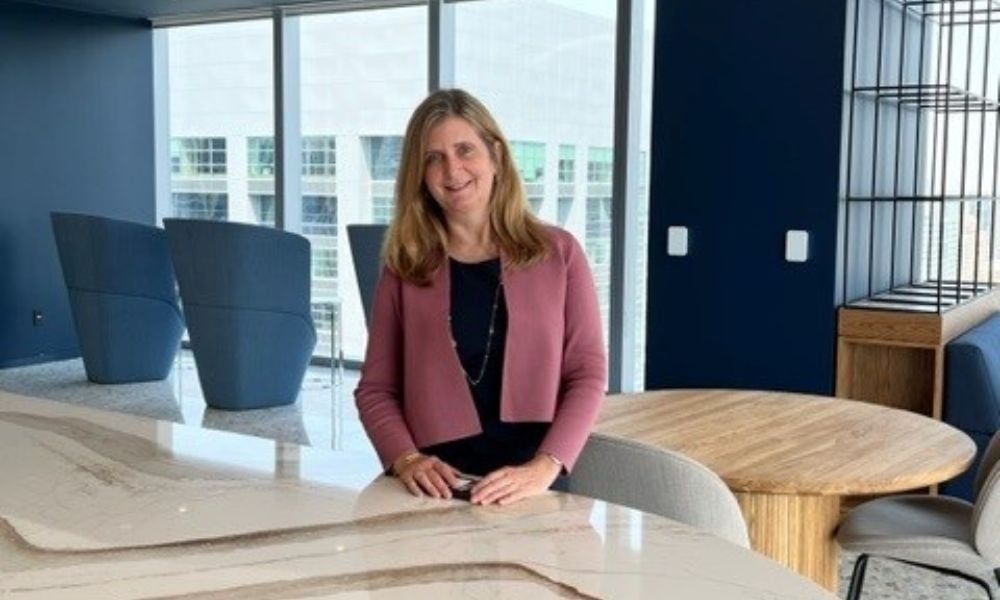Toronto headquarters features smaller offices, more amenities, flexible workspace, light for all

The decision to move Cassels Brock & Blackwell’s Toronto headquarters to a new location may have been made in 2019 before the pandemic, but its design and features reflect post-COVID reality, says Managing Partner Kristin Taylor.
“The good news is that we were able to incorporate a hybrid work-home strategy into the office design for a firm that has seen huge growth recently,” says Taylor.
On Monday, May 29, Cassels and its 520 lawyers and staff officially moved into their offices at 40 Temperance Street – the top five floors in the North Tower of the Bay-Adelaide Centre – not too far from their location for the past 35 years at Scotiabank Plaza on King Steet W.
Not only does the new location allow for the “hotelling” of firm lawyers who are visiting from Cassels offices in Vancouver and Calgary, along with space for hosting events, but it also provides the opportunity to “dream big and be bold about what we wanted our office space to look like.”
She adds: “We made some pretty significant design decisions, and a lot of that was facilitated by what the pandemic taught us and how to incorporate it into our overall strategy.”
Perhaps the most striking difference in the new offices, compared to the old digs, is the “equality of access” to daylight, Taylor says. Trying to make the space more “inclusive” for all who work at Cassels was top of mind.
Taylor says the firm looked at three potential “new builds” and settled on the Temperance Street location because the timing for completion was best, and it was the one closest to the downtown Toronto courts. Given what has happened since the pandemic – with more virtual hearings and fewer trips to the courthouse - the latter reason is perhaps not as critical as before, Taylor says. However, the new build allowed the firm to work with architects and contractors to “build it out from the studs.”
The space is slightly bigger than at the old location, but there are not the same “jagged” corners that were a feature of the Scotiabank building that would have made it hard to add features the firm was looking for.
The result? Gone is the “old partner” setup, where senior lawyers had most of the window space in huge offices. “My partner office was massive. I had a couch and chairs,” she says. “It was a somewhat inefficient use of space and not really reflective of the environment we wanted to project.”
Instead, office sizes for everyone are more equitable, on average about 10 feet by 10 feet, and they have mainly been brought inside from the perimeter. The philosophy behind the overall design is for the best light to be enjoyed by all, Taylor says.
“There are people here whose chins were [figuratively] on the floor. They can’t believe how different the space fees – to move from something quite dark to something more vibrant.” As for the size of offices, Taylor says lawyers and staff gave resounding approval, saying they were larger than they thought they would be.
“I guess we undersold and over-delivered on that.”
In keeping with lessons from the pandemic, Taylor says the new offices have a 4,500-square foot “wellness centre” that includes meditation and yoga space, a fitness centre with Peloton bikes and treadmills, a lactation room for breastfeeding mothers, a religious observance room and a family room where parents can stash kids for a bit with colouring books or games while they finish up their work. There’s even a room for firm clients if they need to work or make calls while visiting the offices.
There are also showers straight off the elevator for anyone who bikes to work.
Says Taylor: “It’s different from your traditional law firm office design, but we thought it was important to set aside space to reflect our values and help with the stresses that lawyers and all staff can face.”
The design also reflects that more people might work from home on more days and that even when they are at the office, they might want a change of scenery, she says. So, there are “flexible” workspaces that range from meeting rooms and offices for confidential conversations, thanks to better soundproofing, to more “collaborative” spaces, like a well-stocked cafeteria where colleagues can chat socially or for work.
Taylor says creating more options for working at the office may only have happened because of the pandemic. “People told us that when working from home, they would move to the couch or curl up somewhere else, just to get a different view.” So those options are featured at the Temperance Street location.
As for hotelling employees from other locations – or for those who chose not to have their own office or didn’t want to commit to coming in at least three days a week – Taylor says there is a way to book an office when needed.
Taylor says about 20 percent of the space is reserved for hotelling, and there’s a “clean desk” policy to ensure that anyone who uses a flexible office isn’t crowded out by someone else’s “stuff.”










